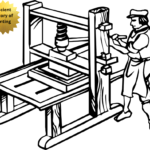The use of glue has been around for a long time. Although it is an old thing in that sense, various rapid changes have been taking place in this regard in the last few decades. There are various types of artificial glues available commercially in the market, so naturally a question arises, which glue can be used for which purpose with the most success? Before finding that answer, let’s discuss the nature of the different types of glue.
Glue is most commonly used in book binding. In most cases, the glue used in binding damages the book. Although glue usually does not cause any damage to the paper, the paper becomes slightly weak when it comes into contact with the glue. Most glues become very hard when they dry and create sharp edges, as a result of which this part can burst in the mouth for some reason. This type of glue is not suitable for use.

The act of gluing is to join two pieces of paper or other media together. This joining can be done either chemically or physically. Physical joining happens like this – the glue creates small holes in the top surface of the paper on which it is applied, and as the glue dries, it forms a small dumbbell-shaped joint between those holes. The two pieces of paper are joined together by the same means. This is noticeable when the cross-section of the piece of paper joined with the help of glue is viewed with the help of a microscope.
The chemical action of a glue can be understood if we do a simple test with two pieces of paper. One of the two pieces of paper is plain paper, the other is coated with wax. If a thin layer of glue is applied to both pieces of paper, it will be seen that even when the plain paper gets wet, the wax paper does not change. This is because the wax coating does not allow the glue to react with the paper. If the glue is of high quality, then the joint made by it is very strong and permanent. When I try to open it with this force, the paper tears, but not when I pull it tightly.
A glue is considered good only when it is able to wet its medium, i.e. paper, well, otherwise the bond cannot be strong. – As happens when you try to glue wax paper to regular paper. For this, the glue also needs to be thin enough so that it can easily spread over and wet the two media (such as paper) that are to be joined.
In addition, the glue needs to be such that it dries easily and in a short time after application.
Stages of Glue
Therefore, it is seen that there are three stages or stages in the process of bonding with glue. For example:
1. The first liquid state (which makes it easy to apply);
2. The second, after proper application, the two papers are kept in a certain position; and
3. The final stage is drying to make them strong.
The second and third stages differ for various types of glue. For example, animal glue gradually cools, thickens, and finally dries, while herbal glue gradually dries through evaporation. The glue used for removal usually dries by evaporation. One of the disadvantages of glues that dry in this way is that often the paper or medium wrinkle slightly as it dries, and if it is too strong, both the medium and the bond become damaged and weak. Another thing to remember when choosing a suitable glue is that the harder the medium, the stronger the glue needs to be. Again, if it is too thin, the application or the paper may become excessively wet and expand, which causes problems during drying and weakens the medium. Keeping these things in mind, it is necessary to select the appropriate glue according to different mediums and different needs.
Kinds of Glue
According to the ingredients used in production, glue can be roughly divided into three categories:
a. Herbal
b. Organic
c. Synthetic
The most widely used glue from the time of ancient Egyptian civilization to the present day, but among herbal glues, starch glue is more common. The main reason for this is that although it takes a little longer to dry than animal glue, it still has all the special qualities that a good glue needs, it is quite cheap, and convenient to use.
Generally, glue is made by mixing 1 part flour or starch with 10 parts water and boiling it properly. This old method has been slightly modified or refined according to the needs of modern times, such as various types of herbal chemical materials are mixed in it to prevent the attack of fungi etc. Compared to flour glue, starch glue is of higher quality and free from most defects.
Usually, some special qualities or religions are added to the glue made through some special methods. For example, if starch can be reacted with acid or alkali or oxidizing agent, then one part starch and one part water can be mixed to make a glue that is not too thick for use. Another method is to fry it with a very small amount of acid on medium heat or without acid on high heat to make white dextrin and yellow British gum respectively. These are easily soluble in cold water and can be mixed in a 1:1 ratio to make a thin glue suitable for use. Such refined starch is available on a commercial basis, making it easy for small libraries to collect as needed.



